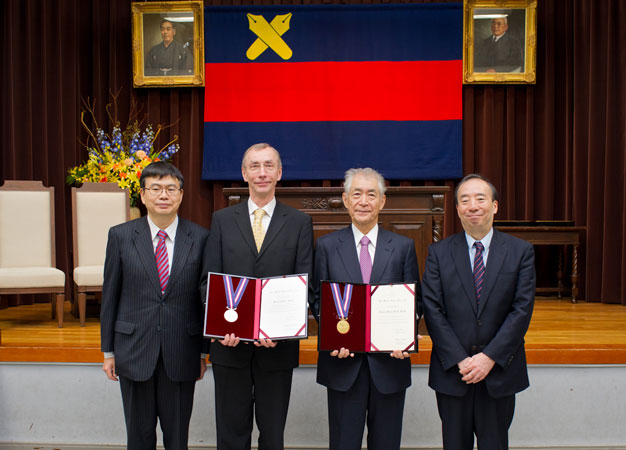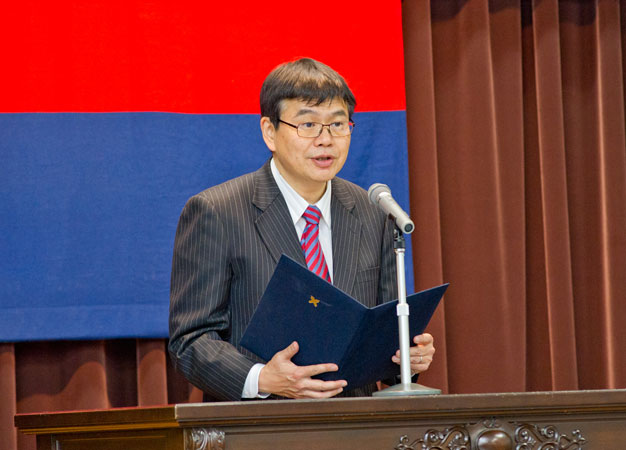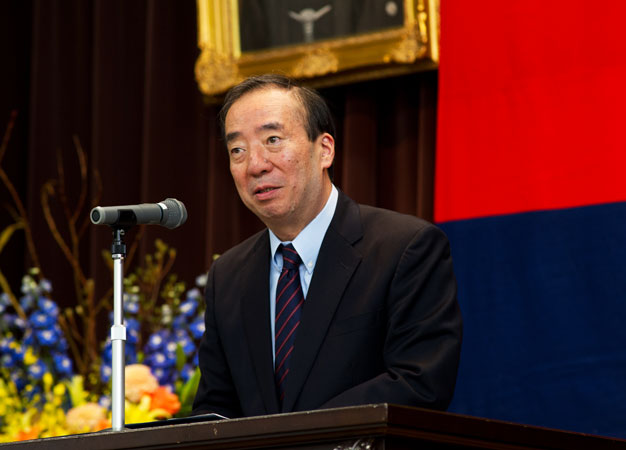The Keio Medical Science Prize recognizes scientific developments that have led to paradigm shifts in medical and life sciences
Published online 27 January 2017

The 21st Keio Medical Science Prize went to Japanese immunologist Tasuku Honjo (center right) and Swedish evolutionary biologist Svante Pääbo (center left). Keio University President Atsushi Seike (right) and professor and dean of the Keio University School of Medicine, Hideyuki Okano (left), congratulated the laureates at an awards ceremony in Tokyo.
© 2017 Keio University
Every year since 1996, Keio University has honored the world's most outstanding medical researchers with The Keio Medical Science Prize, a globally recognized award that reflects the university's commitment to excellence and innovation in education, research and medicine. Remarkably, the prize has anticipated the Nobel Prize on multiple occasions, and seven winners of the Keio Prize have gone on to become Nobel Laureates.
The history of the Keio Prize dates to the early 1990s, when a Keio alumnus called Mitsunada Sakaguchi presented a gift to the university that aimed to spur research in the life sciences and stir the aspirations of young medical scientists.
Sakaguchi had graduated from the prestigious Keio University School of Medicine in 1940. Half a century later, he had not forgotten his alma mater and in 1994, his donation of five billion Japanese yen was used to establish the Keio University Medical Science Fund. His donation, equivalent to US$50 million, was followed several years later by an additional two billion yen. Sakaguchi wished for the money to be used to commend outstanding researchers, encourage medical research and its creative progress at Keio through grants, and promote worldwide medical advances.
The Keio Medical Science Prize is a key project of the Keio University Medical Science Fund, which also provides grants for research and international exchange.
It recognizes outstanding researchers of any nationality, nominated and selected through a rigorous evaluation process. Laureates today receive a certificate of merit, a medal, and a monetary award of 10 million yen (equivalent to US$88,000).
Over the past two decades, the prize has gained prominence as the only one of its kind bestowed by a Japanese university focusing on medical and life sciences. It receives a large number of nominations from all over the world and has recognized researchers from Japan, the United States, Australia, Sweden, and France, covering a wide range of research, from the discovery of infectious proteins to cellular self-digestion.
Global pioneer
Keio University, Japan's oldest private institute of higher learning, was established in 1858 by educator and leading intellectual Yukichi Fukuzawa, who championed reason, observation and verification in science. Today, it ranks among the top ten universities in the world for the number of degrees it has conferred to chief executives, according to the Times Higher Education. Its well-connected network of alumni include three former prime ministers, the first Japanese woman to go to space, and many Olympic medalists.
The Keio University School of Medicine was established in 1917, with microbiologist Shibasaburo Kitasato serving as its first dean. Kitasato was a strong defender of the egalitarian ideals of science for society. He fostered not just doctors, but the next generation of 'physician scientists' committed to pursuing knowledge for the public good.
Keio's mission "is to be a constant source of honorable character and a paragon of intellect and morals for the entire nation," Fukuzawa said in 1896. He aspired for every member of Keio "to apply this spirit to elucidate the essence of family, society, and nation. They will not only articulate this essence in words, but also demonstrate it in their actions, and by so doing make Keio a leader of society." These words resonate today in the high standards set for laureates of The Keio Medical Science Prize.

"We hope that the prize will inspire young students," said Okano, chairman of The Keio Medical Science Prize selection committee.
© 2017 Keio University
Significant contributions
Selection of those laureates ― one Japanese and one non-Japanese each year ― is a painstaking task. Every winter, the Keio Prize committee gathers to begin a year-long process that considers recommendations from all over the world. Candidates are critically assessed for their accomplishments through a rigorous, four-stage vetting process. By the autumn, the winners are announced.
The result of those deliberations is a prize that is unique in recognizing "not just world-firsts, as is often the case with the Nobel Prizes, but also cumulative research that has an impact on human health," says Hideyuki Okano, professor and dean of the Keio University School of Medicine and chairman of the prize selection committee. This distinction is an important one, he says. Significant contributions to medical science can take many different forms.
Keio laureates are selected for having precipitated a paradigm shift in the life sciences. Their original research must have contributed to medical advances. Prizewinners are revered not only for what they have already revealed about the world, but also for the many more discoveries to come. As such, the committee favors younger researchers who are likely to maintain an active involvement in their work long after receiving the accolade ― a criterion that distinguishes the Keio Prize from the Nobel.
Nobel promise
From the beginning, the Keio Prize proved its acuity. The first two laureates in 1996 were American neurologist Stanley Prusiner and Japanese neuroscientist Shigetada Nakanishi. Prusiner had discovered prions, a type of infectious protein that cause many neurodegenerative diseases such as scrapie in sheep and mad cow disease in cows. One year later, in 1997, he received the Nobel Prize in Physiology or Medicine for uncovering this "new biological principle of infection".
For his part, Nakanishi developed a ground-breaking technique for determining the structure, and eventually the function, of neural receptor proteins. In the years since winning the award, the tools he developed have brought into view a deeper understanding of the inner workings of the brain, from learning to memory and movement.
One in every five laureates has since gone on to receive a Nobel Prize.
In 1999 Keio recognized Australian-American biologist Elizabeth Blackburn for her discovery of telomerase, the enzyme responsible for capping the ends of chromosomes. The protective caps, known as telomeres, have been found to play an important role in cellular aging and the immortality of cancer cells. A decade after receiving the Keio Prize, Blackburn was awarded a Nobel in 2009.
Most recently, the Nobel Prize in Physiology or Medicine 2016 went to Japanese molecular biologist Yoshinori Ohsumi, one year after he received the Keio Prize. Ohsumi determined the process by which cells degrade and recycle their own contents, known as autophagy. He described the Keio medal as "a great honor".
Cancer targets and Neanderthals
On 1 December 2016, Keio inducted its newest laureates at a grand event complete with a student string orchestra at Kitasato Memorial Hall, Keio University School of Medicine. Japanese immunologist Tasuku Honjo, who discovered a promising drug in the fight against cancer, and Swedish evolutionary biologist Svante Pääbo, who is responsible for sequencing the entire genome of our distant ancestors, the Neanderthals, were the recipients.
"Both professors Honjo and Pääbo are outstanding researchers who exemplify the criteria of the prize: advancing medical and life sciences, cultivating new paradigms and continuing to be active in research," says Okano, who welcomed the audience of 300, including many high-profile guests. Keio University President Atsushi Seike congratulated Pääbo and Honjo on their accomplishments before conferring them with certificates and medals decorated with the Keio colors, blue and red. "This year's awards celebrate a truly wide scope of research, with one having an impact on lives in the future and the other reaching far back in time," he said.

"This year's awards celebrate a truly wide scope of research, with one having an impact on lives in the future and the other reaching far back in time," said President Seike.
© 2017 Keio University
Both laureates gave commemorative lectures after receiving their awards. Honjo described The Keio Medical Science Prize as a "visionary" award that takes a long-term view of the value of basic research. "I am very honored by the prize and extraordinarily humbled to be among such outstanding recipients," he said. "Curiosity was the starting point of my career as a medical researcher. Fortunately, this has led to results that may be beneficial to many people."
"I am deeply honored to receive the prize," said Pääbo in his acceptance speech. "I share this award with many people in my laboratory and elsewhere."
The 2016 nomination process involved a total of 3,142 academics and researchers from Japan and overseas, representing 40 countries. More than 100 nominations were put forward and assessed by members of the selection committee together with a large panel of experts from external institutions and Keio University. "The selection, the achievement, I find it very rewarding," says Okano, who will soon begin the exhaustive process of choosing the 2017 laureates. Calls for nominations go out in late January, with a deadline in early March.
A lasting legacy
In many ways, The Keio Medical Science Prize encapsulates the founding principles of Keio's School of Medicine, which strives to be a pioneer in the world of clinical and medical studies. In 2017, the school will turn 100, and it has invited former prize laureates to give commemorative lectures at the centennial celebrations.
By honoring researchers who embody Keio's ideals in their work, The Keio Medical Science Prize acts as a driving force for ambitious young scientists. Students at Keio's School of Medicine are welcome at the annual award ceremonies, and given an opportunity to see researchers who are active in the global frontlines.
"We hope that the prize will inspire young students in particular," says Okano. "It is our hope that Keio Medical Science Prize Laureates serve as role models in terms of how they approach and conduct their research."